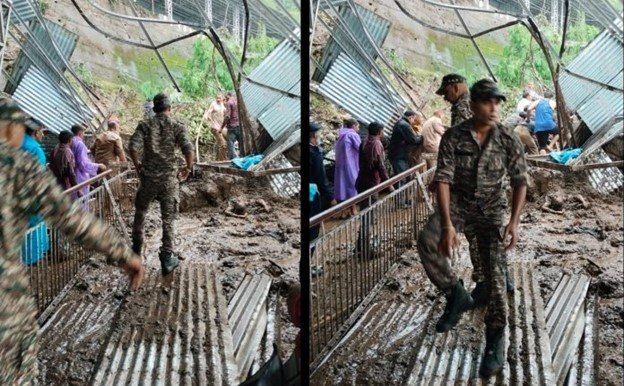A Pilgrimage Turned into Tragedy
By: Javid Amin | 27 Aug 2025
What was meant to be a sacred journey of devotion turned into a scene of unimaginable horror on August 26, 2025. A massive landslide struck the Shri Mata Vaishno Devi shrine route near Adhkuwari in Reasi district, Jammu, claiming at least 32 lives and injuring over 20 devotees. Triggered by relentless, heavy rainfall that has battered Jammu & Kashmir for days, the disaster has forced the suspension of the Vaishno Devi yatra.
As rescue teams battle mud, boulders, and continuing rainfall, this tragedy underscores not just the fragility of Himalayan terrain but also the increasing frequency of extreme weather events in the region.
Shri Mata Vaishno Devi Shrine – Symbol of Faith
The Vaishno Devi shrine is one of the most revered Hindu pilgrimage sites, drawing nearly 10 million pilgrims annually. Located at an altitude of about 5,200 feet in the Trikuta hills, the journey is as spiritual as it is challenging. Pilgrims trek along steep, winding routes from Katra base camp to reach the holy cave.
For many, this pilgrimage represents hope, blessings, and faith. That the tragedy struck here, during the yatra, has made the loss all the more painful.
How the Disaster Unfolded
-
Time & Place: Around 3:00 PM, torrential rains loosened rocks and mud along the Adhkuwari stretch.
-
Sudden Collapse: Massive boulders rolled down, bringing with them tons of debris that buried sections of the pathway.
-
Caught Off-Guard: Hundreds of pilgrims were on the route at the time, many en route to pay their respects at the shrine.
-
Immediate Chaos: Panic spread as devotees scrambled for safety. Some were trapped under fallen debris, while others sustained injuries from falling rocks.
Rescue teams described the scene as “utter devastation.”
Immediate Impacts
🔴 Pilgrimage Suspended
The Vaishno Devi yatra was halted immediately. Both the Himkoti route and the old traditional path have been closed due to unsafe conditions.
🛠️ Rescue Operations
-
Indian Army, Shrine Board, J&K Police, and CRPF launched joint rescue missions.
-
Indian Air Force helicopters have joined ground operations to airlift injured individuals.
-
NDRF and SDRF are combing through debris to locate missing devotees.
🏚️ Infrastructure Damage
-
Landslides and flash floods have cut off highways and damaged multiple bridges.
-
Widespread power outages and mobile network failures have disrupted communication.
📚 Schools & Exams Postponed
All educational institutions in Jammu division have been ordered shut until August 27, while board exams stand postponed.
🌧️ Kashmir Valley Also Hit
While Reasi suffered the worst landslide, Kishtwar, Doda, Ramban, and parts of South Kashmir reported cloudbursts, flash floods, and casualties.
Rising Death Toll
Initially reported at 12 fatalities, the death toll steadily climbed as rescue workers pulled more bodies from beneath boulders and mud. As of the latest update:
-
32 confirmed dead
-
20+ injured, several in critical condition at hospitals in Katra and Jammu
-
Officials fear the toll may rise further, with some pilgrims still missing.
The grim scale of the tragedy has left families shattered, and the entire nation mourning.
Government Response & Leaders’ Condolences
-
Prime Minister Narendra Modi expressed deep sorrow and assured full central support. His office announced ex-gratia relief for victims’ families.
-
Home Minister Amit Shah praised the courage of rescue teams, promising quick restoration of the yatra route once conditions permit.
-
J&K Lieutenant Governor Manoj Sinha personally reviewed the situation, directing all departments to prioritize rescue and relief.
The Shrine Board has requested pilgrims to postpone travel plans until the weather stabilizes.
Why Jammu & Kashmir is So Vulnerable
Fragile Mountain Ecosystem
The Himalayas are geologically young mountains, prone to landslides and erosion. Heavy rains destabilize slopes easily.
Human Pressure
Millions of pilgrims, unregulated construction, and road widening projects put additional stress on fragile terrain.
Climate Change
Scientists warn that climate change is making rainfall more erratic and intense. Cloudbursts and flash floods are becoming more frequent in J&K.
Historical Precedents
-
2014 Kashmir floods: Displaced millions, killed over 500.
-
Kishtwar 2021 cloudburst: Over 20 lives lost.
-
Amarnath 2022 floods: Claimed 16 lives.
This latest Vaishno Devi tragedy is part of a growing pattern.
Heartbreaking Human Stories
-
A family from Delhi lost three members who were on their first pilgrimage.
-
Survivors recount scenes of chaos and fear, with people clinging to railings as rocks thundered down.
-
Local volunteers and shrine workers risked their lives to pull people out of rubble.
Such accounts highlight both the fragility of life in the face of natural forces and the resilience of communities.
Lessons & The Road Ahead
Experts stress urgent measures:
-
Stronger Early Warning Systems for landslides and flash floods.
-
Infrastructure Audit of pilgrimage routes like Vaishno Devi and Amarnath.
-
Regulated Pilgrimage Traffic to reduce overcrowding.
-
Eco-Friendly Construction instead of reckless road cutting.
-
Community Disaster Preparedness training for locals and shrine staff.
Preparedness is the key to avoiding future tragedies.
Key Statistics
-
Annual pilgrims at Vaishno Devi: ~10 million
-
Average August rainfall in Jammu: 240 mm (2025 saw nearly double in some areas)
-
Landslides in J&K: On average, 80+ annually block the Jammu–Srinagar highway
-
Disasters in last decade: Floods (2014), cloudbursts (2021, 2022), landslides (2025) — showing an increasing trend
Bottom-Line: A Wake-Up Call from the Mountains
The Vaishno Devi landslide is not just a natural disaster — it is a warning. It reminds us that development, faith-based tourism, and human safety must always be balanced with ecological realities.
As the nation prays for the victims and their families, it is time to rethink how we interact with fragile Himalayan ecosystems. The sacred mountains demand respect, resilience, and responsibility.


